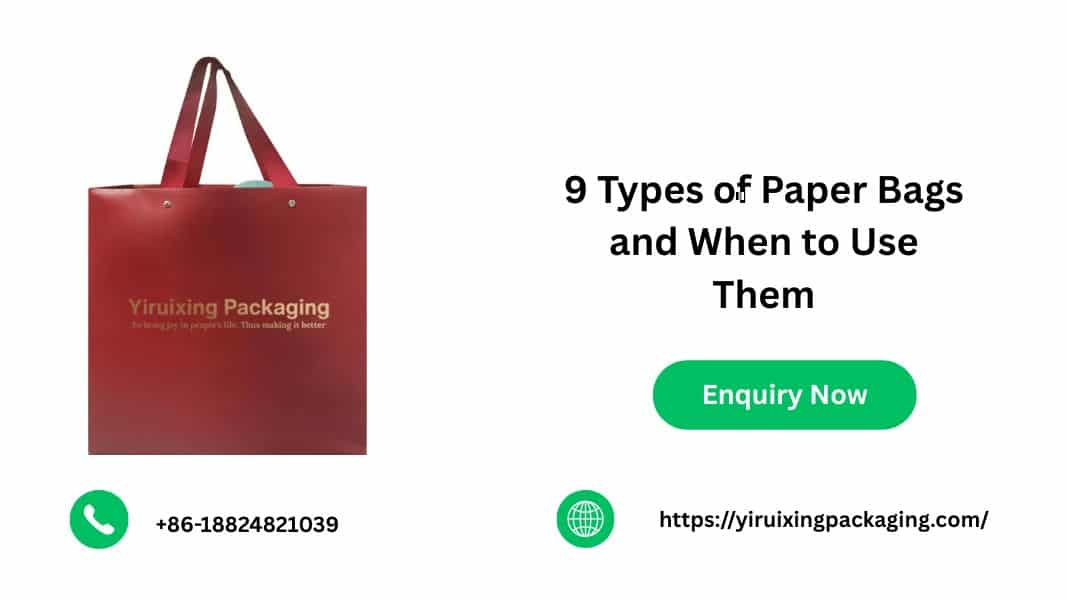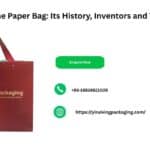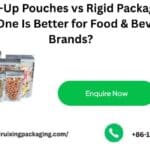9 Types of Paper Bags and When to Use Them – Paper bags are a multi-purpose and sustainable alternative to plastic bags available in many shapes, sizes, and materials. Whether owning a retail store, planning an event, or searching for sustainable packaging, when you know the different types of paper bags and their recommended uses, your options can be a lot easier to choose from. In this blog post, we will discuss the 9 types of paper bags available and their perfect uses.
Table of Contents
Toggle9 Types of Paper Bags
Here is a comprehensive list of the 9 styles of paper bags available –
1. Flat Paper Bags
Flat paper bags are basic paper bags that are lightweight without a gusset (side fold). Flat paper bags are typically used for bakeries, pharmacies, or very lightweight items. When to use it –
Packaging/giving out small products like greeting cards or candy.
Holding an individual prescription at the pharmacy.
Wrapping a sandwich or pastry for takeout.
Advantages – Affordability, recyclable, space-saving.
Disadvantages – Limited volume and not suitable for heavy products.
2. Gusseted Paper Bags
Gusseted bags have side folds that allow for expansion, which allows for more room for your products. Gusseted paper bags are available in many different sizes and strengths. When to use it –
Carrying groceries or takeout meals.
Packing clothing or books in a retail environment.
Packing/storing food containers.
Advantages – Expandable, well-constructed, and multipurpose.
Disadvantages – More cost than flat bags.
3. SOS Bags (Self-Opening Square Bags)
Generally seen in lunch settings or food delivery, SOS bags stand upright when opened, making them right for filling. When to use –
Fast-food restaurants and cafeterias
Carrying boxed lunches or baked items
Organizing craft supplies or hardware.
Advantage – Free-standing, easy to fill, recyclable.
Disadvantage – Not moisture-proof without an inner lining.
4. Pinch-Bottom Paper Bags
These feature a pinch-bottom seal that creates a sturdy base. They are frequently used in the food sector with an added lining. When to use –
Holding baked items like cookies or muffins
Packaging coffee, tea, or ground spices
Showing small snack packs or treats
Advantage – Great for branding, customizable.
Disadvantage – May need lining to prevent leakage or grease stains.
5. Reinforced Handle Paper Bags
Equipped for twisted or flat handles, these bags are made for bulky loads. You will see them generally in fashion stores or boutique outlets. When to use –
Retail stores selling clothing, shoes, or accessories
Corporate gift packaging
Upscale food or wine packaging
Advantage – Strong and stylish, good for branding.
Disadvantage – More expensive than handle-free options.
6. Die-Cut Handle Paper Bags
These have a punched-out handle and give a sleek, contemporary look. They are frequently used at trade shows, salons, and premium stores. When to use –
Carrying promotional materials or giveaways
Packaging luxury cosmetics or skincare
Minimalist product packaging
Advantage – Aesthetic look, reusable, compact.
Disadvantage – The handle can tear with heavy items.
7. Kraft Paper Bags
Made from unbleached pulp, kraft paper bags are durable, biodegradable, and have a natural brown color. They are highly sustainable. When to use –
Grocery shopping or farmers’ markets
Eco-conscious brands’ product packaging
Compostable food containers
Advantage – Environmentally friendly, strong, and affordable.
Disadvantage – Less visual appeal unless customized.
8. Laminated Paper Bags
These bags feature a glossy or matte finish that gives them a premium look and added durability. They frequently include rope handles. When to use –
High-end retail packaging
Corporate gifts or luxury branding
Special occasions or events
Advantage – Stylish finish, water-proof.
Disadvantage – Not fully recyclable due to the lamination.
9. Custom-Printed Paper Bags
These are customized for businesses seeking to reinforce brand identity. Custom-printed bags can include logos, colors, and designs particular to your brand. When to use –
Branding for retail stores and pop-up shops
Product launches or exhibitions
Promotional or seasonal marketing campaigns
Advantage – Powerful marketing tool, unique design
Disadvantage – Minimum order quantities may apply.
Selecting the Right Paper Bag for Your Needs
When deciding on which type of paper bag to use, think about the following: –
Weight of the products – Select reinforced or gusseted bags for heavier loads.
Aesthetic requirements – Laminated or custom-printed bags provide a premium look.
Environmental goals – Kraft paper and SOS bags are amazing, eco-friendly options.
Budget constraints – Flat or pinch-bottom bags are generally more affordable.
Conclusion
Selecting the right type of paper bag depends on your product, budget, and sustainability goals. From flat paper bags to high-end laminated ones, there is a paper bag for every purpose. Not only are they functional, but they also make a lasting impression when tailored. For premium-quality custom paper bags, Yiruixing Packaging provides expert solutions customized to your brand. Their sustainable and stylish packaging ensures your products stand out while staying eco-friendly.
FAQs About Types of Paper Bags
Are all paper bags recyclable?
Most paper bags are recyclable, specifically kraft and flat paper bags. However, laminated bags or those with plastic linings may not be recyclable in all regions.
Can paper bags be utilized for food packaging?
Yes, specifically pinch-bottom, SOS, and gusseted paper bags. Some even come with food-safe linings to prevent leaks and grease stains.
What is the most eco-friendly paper bag?
Kraft paper bags are the most eco-friendly as they are made from unbleached pulp, are biodegradable, and need less processing.
From where can I customize paper bags for my business?
You can contact packaging manufacturers such as Yiruixing Packaging to create custom-printed bags with the brand’s logo, colors, and messaging.





